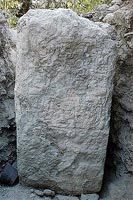 Women played a significant role in Maya culture and began to wield power much earlier than previously thought by archaeologists.
Women played a significant role in Maya culture and began to wield power much earlier than previously thought by archaeologists.
Researchers working in Guatemala have uncovered a stela depicting a powerful woman in ancient Maya civilization. “The 2-meter tall stela features the portrait of a woman who may have been a leader or a goddess,” said Kathryn Reese-Taylor, a professor at the University of Calgary.
This stela dates back to the 4th century CE, 200 years earlier than previously discovered stelae that depicted powerful Maya women.
“We have images of queens, independent rulers, or those who ruled alongside their husbands or sons, depicted on stelae from later periods in Maya history, starting in the early 6th century. But this newly discovered stela is entirely unique in style and dates back to the 4th century CE,” Reese-Taylor explained. “It is distinctive in that it portrays a woman from the very early period of Maya history, when new cities were being constructed and new empires were being established.”
Archaeologists found the stela—typically used to commemorate events in the lives of kings—at Naachtun, located over 90 kilometers north of the more famous ancient city of Tikal.
It was buried within an ancient structure, and some inscriptions were worn away, indicating that the stela was damaged during an invasion by Tikal’s forces in the late 5th century.
The name of the woman on the stela is translated as Lady Partition Lord. An infant was also buried alongside the stela.
Researchers do not believe that Maya culture followed a matriarchal system, but they assert that women played a crucial role from the early stages of societal development.
M.T. (ABC Online)





















































